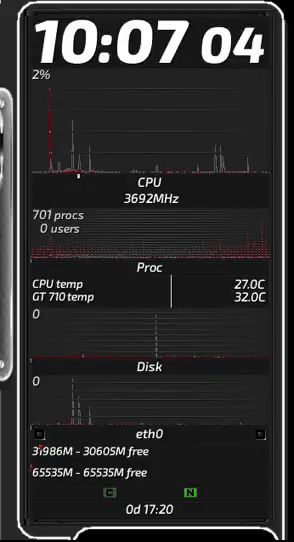In the documentation (https://www.kernel.org/doc/Documentation/cpu-freq/user-guide.txt) I found various ways to modify the CPU frequency. But I want to know what happens after a command is sent. E.g., if I change the frequency file, how can that influence the actual frequency?
You are using an out of date browser. It may not display this or other websites correctly.
You should upgrade or use an alternative browser.
You should upgrade or use an alternative browser.
What is the process of changing CPU Frequency?
- Thread starter beann
- Start date
This link should help. Scroll down to Section 3 and that explains it well enough:
 wiki.archlinux.org
wiki.archlinux.org
CPU frequency scaling - ArchWiki
Thank you for your reply! I have seen this before. But it does not explain the mechanism. E.g., if I change the min_frequency and max_frequency file, what will happen? How can I make sure the frequency is really changed?This link should help. Scroll down to Section 3 and that explains it well enough:
CPU frequency scaling - ArchWiki
wiki.archlinux.org
Yeah, If I set these files to the same value CPU will stay in a fixed value. But how can the CPU know which frequency to set? If I want to know the change delay, how can I measure it? This command may not have enough precision?If you do that, you're CPU will stay between those two frequencies,
To check it, run 'lscpu | grep MHz' and that'll spit out your min and max frequencies.
The CPU knows because the kernel tells it that it needs more processing power, so it will scale to the needs as best as possible. The delay will be trivial. You could write a script that runs the command and logs the changes every few seconds, but I'm mot sure you're going to learn anything useful. Just set it where you want and know the kernel works as intended.
Thank you for your reply! Actually, I want to do some fine-grained control (micro second level), so I was wondering how can I change the frequency fastest.
The CPU knows because the kernel tells it that it needs more processing power, so it will scale to the needs as best as possible. The delay will be trivial. You could write a script that runs the command and logs the changes every few seconds, but I'm mot sure you're going to learn anything useful. Just set it where you want and know the kernel works as intended.
There's no rule that says you have to have different values. So, if you want a specific frequency you can just set it at the minimal and maximum. It is indeed taking place in microseconds on a modern computer. The kernel is well-adapted for this. Unless you really need to, I'd not mess with it. You seem to be quite eager, which is just fine. It's Linux, and that's awesome that you can dig into these things. I am curious about your end goal, however. What exactly are you trying to accomplish.
I was trying to optimize the latency of frequency changing (to approximate the upper bound, i.e., hardware latency). So I was wondering how large is the OS overhead, and if it is possible to skip some of them to get a speedup.
Thank you for your answer. It seems I need working on the kernel, I guess maybe I can build it from the userspace govenor with a new daemon?Hmm... That's beyond my skill level but I'm pretty sure that'd mean mucking about with the kernel, changing things like priorities.
Heh. It's the same on every Linux forum I've ever visited/joined up with. It's always the 'Beginners/Noobs' sections where you find the most ridiculously technical - and often, utterly pointless - questions being asked....
@beann :- Just out of curiosity, why would you NEED to be able to change your CPU frequency on a second by second basis? I fail to see what possible use it could have.
If you want to be able to view your CPU frequency literally by-the-second, install the gKrellM system monitor. And then, install the gkx86info plugin. And what you get is this:-

Below the legend for the top CPU graph (you can have one for every core if you want, but it uses a lot of screen real-estate if you've got a lot of cores; me, I prefer a single composite graph) you will see the gkx86info plugin in action.......displaying the CPU frequency second-by-second.
I do like my toys!
Works for me. There's quite probably CLI solutions that will do the same thing, although gKrellM is not exactly resource-heavy.....quite the opposite, in fact.
------------------------------------------
Kernel compilation is not the easy process you might imagine it to be. This page from the Arch Linux wiki - one of the best sources of information anywhere in the open-source world - may give you some pointers. Do bear in mind, however, that these commands are specific to Arch Linux.......though it'll be easy enough to modify them for most mainstream distros.
 wiki.archlinux.org
wiki.archlinux.org
Mike.
@beann :- Just out of curiosity, why would you NEED to be able to change your CPU frequency on a second by second basis? I fail to see what possible use it could have.
If you want to be able to view your CPU frequency literally by-the-second, install the gKrellM system monitor. And then, install the gkx86info plugin. And what you get is this:-

Below the legend for the top CPU graph (you can have one for every core if you want, but it uses a lot of screen real-estate if you've got a lot of cores; me, I prefer a single composite graph) you will see the gkx86info plugin in action.......displaying the CPU frequency second-by-second.
I do like my toys!
Works for me. There's quite probably CLI solutions that will do the same thing, although gKrellM is not exactly resource-heavy.....quite the opposite, in fact.
------------------------------------------
Kernel compilation is not the easy process you might imagine it to be. This page from the Arch Linux wiki - one of the best sources of information anywhere in the open-source world - may give you some pointers. Do bear in mind, however, that these commands are specific to Arch Linux.......though it'll be easy enough to modify them for most mainstream distros.
Kernel/Traditional compilation - ArchWiki
Mike.
Last edited:
Thank you, I'll try these.Heh. It's the same on every Linux forum I've ever visited/joined up with. It's always the 'Beginners/Noobs' sections where you find the most ridiculously technical - and often, utterly pointless - questions being asked....
@beann :- Just out of curiosity, why would you NEED to be able to change your CPU frequency on a second by second basis? I fail to see what possible use it could have.
If you want to be able to view your CPU frequency literally by-the-second, install the gKrellM system monitor. And then, install the gkx86info plugin. And what you get is this:-

Below the legend for the top CPU graph (you can have one for every core if you want, but it uses a lot of screen real-estate if you've got a lot of cores; me, I prefer a single composite graph) you will see the gkx86info plugin in action.......displaying the CPU frequency second-by-second.
I do like my toys!
Works for me. There's quite probably CLI solutions that will do the same thing, although gKrellM is not exactly resource-heavy.....quite the opposite, in fact.
------------------------------------------
Kernel compilation is not the easy process you might imagine it to be. This page from the Arch Linux wiki - one of the best sources of information anywhere in the open-source world - may give you some pointers. Do bear in mind, however, that these commands are specific to Arch Linux.......though it'll be easy enough to modify them for most mainstream distros.
Kernel/Traditional compilation - ArchWiki
wiki.archlinux.org
Mike.
Staff online
-
JasKinasisSuper Moderator
Members online
Total: 1,090 (members: 6, guests: 1,084)


